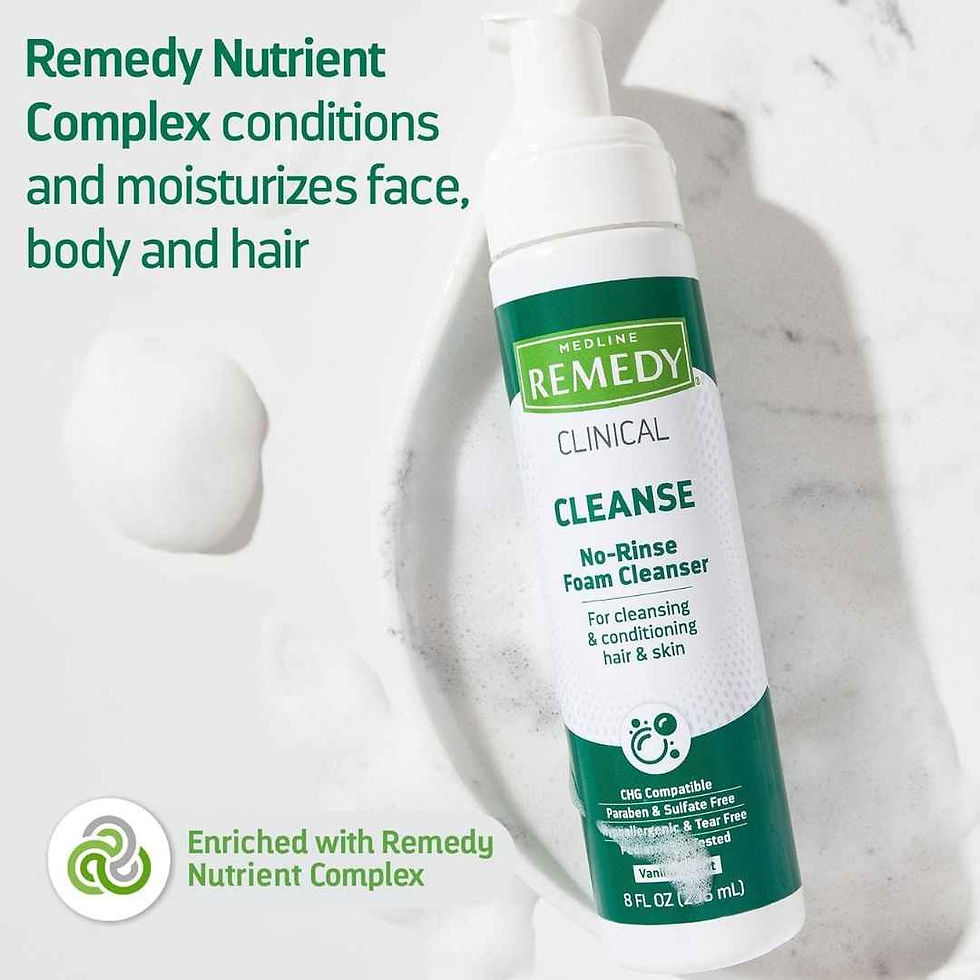Simplifying Bath Time With A No-Rinse Bath
- Elder Love USA
- Jul 24
- 4 min read
Bathing is essential for personal hygiene, but for many older adults, it can become a challenging task due to mobility issues, fear of falling, or cognitive challenges.
In such cases, no-rinse bathing solutions offer a simple yet effective alternative to traditional bathing. These solutions can significantly ease the bathing process for individuals who may struggle with water or physical limitations.

What is a No-Rinse Bath?
A no-rinse bath is a bathing method that doesn’t require the use of water to clean the body. Instead, it uses special no-rinse bathing products, such as soaps, shampoos, or wipes, designed to clean and freshen the skin without the need for rinsing. This option can be particularly helpful for bed-bound individuals or those with limited mobility. A study published in 2017 found that no-rinse bathing was just as effective—if not more so—than traditional bed baths in preventing skin issues and ensuring a more complete bath. While the researchers did note the need for more studies, the results indicated that no-rinse bathing could be a valuable method, especially for those with mobility challenges. It’s also important to note that how often you bathe your loved one depends on their individual needs.
The Difference No-Rinse Products
No-Rinse Shampoo
No-rinse shampoo is specifically formulated to clean the hair without the need for water. These shampoos typically come in spray or foam form, and they cleanse the scalp and hair by breaking down oils and dirt. After massaging the product into the hair, it is wiped away with a towel or washcloth, leaving the hair fresh and clean.
No-Rinse Wipes
No-rinse wipes are pre-moistened with a cleaning solution that helps remove dirt, oils, and sweat from the skin. They can be used on any part of the body, making them ideal for quick cleaning and refreshing.
No-Rinse Shower Caps
Designed for quick and convenient hair cleaning without the use of water. Typically, these caps are infused with a shampoo solution that allows individuals to clean their hair by simply massaging the cap into their hair for a few minutes. Below are some recommended no-rinse products that can make caregiving easier. When you purchase through these links, we receive a small commission, which helps support our mission to provide affordable in-home care for older adults. Thank you for supporting us!

Medline Remedy Phytoplex Cleansing Foam Sulfate-free, low-sudsing foam gently cleanses and hydrates skin and hair. It can be used as a no-rinse body wash or shampoo and is clinically tested to be hypoallergenic and non-irritating.

Scrubzz Disposable Rinse-Free Bathing Wipes
Water-activated, soap and shampoo-infused wipes. Hypoallergenic, pH-balanced, and large enough for complete coverage. They come in a resealable pack of 25 for easy use anywhere.

Nurture Microwavable Rinse-Free Shampoo Caps
Pre-filled with shampoo and conditioner, they are microwavable for added comfort and convenience. The soothing formula, enriched with Aloe Vera and Vitamin E, is gentle and safe for sensitive skin.
Preparing for a No-Rinse Bath
Before starting a no-rinse bath, make sure both you and your loved one are prepared. Having everything ready helps make the process smoother and more comfortable.
Materials You’ll Need
Towels
Enough to cover private areas, for drying, and applying the no-rinse solution.
No-Rinse Soap and Shampoo
Specifically designed to cleanse without water.
Warm Water
To moisten towels for applying soap.
Gloves
For hygiene and to avoid direct contact with bodily fluids.
Bag
To dispose of dirty towels or clothing after the bath.
Clean Clothes
Fresh clothes for your loved one after the bath.
Prepare the Person
Ask your loved one if there’s anything you can do to make the bath more comfortable, such as playing music, dimming the lights, or locking the door for privacy. Try to explain what you are going to do before doing it. For example, tell them that you are going to part this part of their body now.
Step-by-Step No-Rinse Bathing Process
Start with Least Distressing Areas Begin with areas that are least stressful, like the hands or feet. This approach builds trust and comfort.
Cover Areas Not Being Washed Keep parts of the body not being washed covered with towels or blankets to maintain warmth and dignity.
Washing Technique Dampen a clean washcloth or towel with warm water and apply the no-rinse soap or shampoo, following the product instructions. Gently cleanse the skin, paying attention to areas like folds and creases. For bedridden individuals, bend their limbs as comfortably as possible to reach the back of the knees and other hard-to-reach areas.
Drying Use a dry towel to gently wipe away any residue and moisture. Avoid rubbing too harshly.
Dressing Help your loved one put on clean clothes to complete the bath.
Post-Washing
Once the bath is finished, check in with your loved one to see if they have any preferences for drying off, getting dressed, or simply relaxing. Respect their wishes and give them the space to express what makes them most comfortable.
Other Tips
Encourage independence wherever possible. Allow your loved one to wipe areas they can reach themselves. Frequent bathing may not be necessary for older adults with fragile skin, but for individuals with incontinence, daily cleaning of affected areas may be required.
This article is brought to you by Elder Love USA, a leading nonprofit provider of home care services in Riverside County, CA, San Diego County, CA, San Bernardino County, CA, Orange County, CA, Imperial County, CA, and Phoenix, AZ.
Our mission is to provide compassionate and affordable in-home care for older adults in need.



Comments